|
|
Week #5, 02-08.October, 2005
|
Ohioview, PA to Parkersburg, WV: Ohio River Mile 32 to Mile 187 |
| |
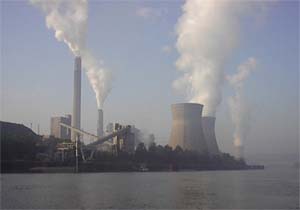 We awoke on Sunday morning to find ourselves still about 70 miles from the school we were scheduled to visit on Monday. So, we gritted our teeth and turned on the motor, not wishing to fall behind schedule yet again. As we rounded one of the first bends in the river, we spotted the source of the white smoke that we had noticed the night before. The locals just up river had told us to keep our eyes open for the sight, but there was no way we could have missed it--the tall, rotund cooling towers of a nuclear power plant. It was quite a feeling to be gliding past these huge power generators in our small craft. In addition to being a nuclear power plant, you can tell from the above picture that this plant also used coal to create electricity because of the tall, skinny chimneys to the left in the photo. We awoke on Sunday morning to find ourselves still about 70 miles from the school we were scheduled to visit on Monday. So, we gritted our teeth and turned on the motor, not wishing to fall behind schedule yet again. As we rounded one of the first bends in the river, we spotted the source of the white smoke that we had noticed the night before. The locals just up river had told us to keep our eyes open for the sight, but there was no way we could have missed it--the tall, rotund cooling towers of a nuclear power plant. It was quite a feeling to be gliding past these huge power generators in our small craft. In addition to being a nuclear power plant, you can tell from the above picture that this plant also used coal to create electricity because of the tall, skinny chimneys to the left in the photo.
|
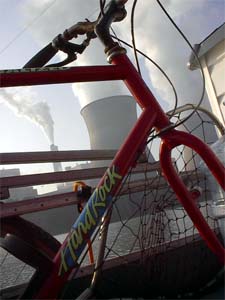 The picture to the left composes an interesting juxtaposition of bicycle power and nuclear power, perhaps making some sort of powerful statement? Whoa. This week was the first in our journey that really exposed us to the amount of industry along the river. In addition to a number of power plants, we also passed facilities involved in barge shipping and all sorts of goods being manufactured. The charts we have usually note what company is set up along the river, so if we know the company name, we can guess what is going on inside the factory. For example, we passed the Bayer plant, so we could presume that aspirin, or some ingredient of aspirin, was being manufactured inside, but when the chart just says "Koppers Industries, Inc." all we can do is guess! The picture to the left composes an interesting juxtaposition of bicycle power and nuclear power, perhaps making some sort of powerful statement? Whoa. This week was the first in our journey that really exposed us to the amount of industry along the river. In addition to a number of power plants, we also passed facilities involved in barge shipping and all sorts of goods being manufactured. The charts we have usually note what company is set up along the river, so if we know the company name, we can guess what is going on inside the factory. For example, we passed the Bayer plant, so we could presume that aspirin, or some ingredient of aspirin, was being manufactured inside, but when the chart just says "Koppers Industries, Inc." all we can do is guess!
|
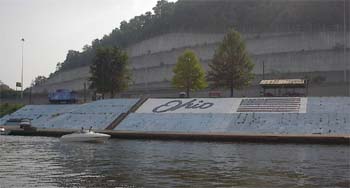 Still early in the day on Sunday we left Pennsylvania and the river became a state line, with Ohio on the right and West Virginia on the left. It won't be until about mid-December when we are once again within a state instead of being along its border. Nothing really changed along the river when we crossed over, but we did get a nice big welcome from Ohio, as shown in the picture on the right. As it turned out West Virginia was equally welcoming--we pulled up next to a dock after a long day on the water and almost immediately met a fellow who offered us his car in order to drive to town and get supplies. How could we refuse? We gratefully accepted his offer and he sent us off in his car, but not before he put a CD in his stereo so we would have some music to accompany our trip around town. Due to this good fortune, we were able to do some grocery shopping, stop at the hardware store, pick up some more gas, and grab a bite to eat--quite a luxury! Still early in the day on Sunday we left Pennsylvania and the river became a state line, with Ohio on the right and West Virginia on the left. It won't be until about mid-December when we are once again within a state instead of being along its border. Nothing really changed along the river when we crossed over, but we did get a nice big welcome from Ohio, as shown in the picture on the right. As it turned out West Virginia was equally welcoming--we pulled up next to a dock after a long day on the water and almost immediately met a fellow who offered us his car in order to drive to town and get supplies. How could we refuse? We gratefully accepted his offer and he sent us off in his car, but not before he put a CD in his stereo so we would have some music to accompany our trip around town. Due to this good fortune, we were able to do some grocery shopping, stop at the hardware store, pick up some more gas, and grab a bite to eat--quite a luxury!
|
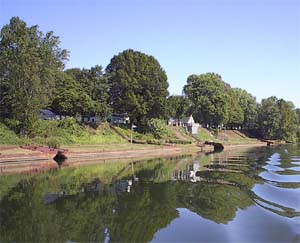 The next afternoon the people of West Virginia once again came through for us. We arrived at Moundsville, WV with little time to spare and quickly ran the boat into mud and set the spud. As we made our way up the embankment with all of the classroom gear, two construction workers on the roof of a house noticed the strange arrival. They questioned us and quickly offered to give us a lift to the school when they learned of our purpose. After the school presentation we did a quick walk around town and learned that the creek we had pulled into--Little Grave Creek--was related to the name of the town itself. Moundsville gets its name from a large mound that researchers believe was used as an Indian burial ground. We set off down the river once again. Another surprising thing we've seen along the river is the number of old barges left along the banks. At first glance, one might think they are simply abandoned--which they are--but they have been abandoned there for a reason. They have been left along the side of the river to keep the banks from eroding away--to help keep the river in its place. In this picture to the left, it looks like the locals have taken advantage of the old barges and extended their yards onto the tops, adding grass, flagpoles, and the like. The next afternoon the people of West Virginia once again came through for us. We arrived at Moundsville, WV with little time to spare and quickly ran the boat into mud and set the spud. As we made our way up the embankment with all of the classroom gear, two construction workers on the roof of a house noticed the strange arrival. They questioned us and quickly offered to give us a lift to the school when they learned of our purpose. After the school presentation we did a quick walk around town and learned that the creek we had pulled into--Little Grave Creek--was related to the name of the town itself. Moundsville gets its name from a large mound that researchers believe was used as an Indian burial ground. We set off down the river once again. Another surprising thing we've seen along the river is the number of old barges left along the banks. At first glance, one might think they are simply abandoned--which they are--but they have been abandoned there for a reason. They have been left along the side of the river to keep the banks from eroding away--to help keep the river in its place. In this picture to the left, it looks like the locals have taken advantage of the old barges and extended their yards onto the tops, adding grass, flagpoles, and the like.
|
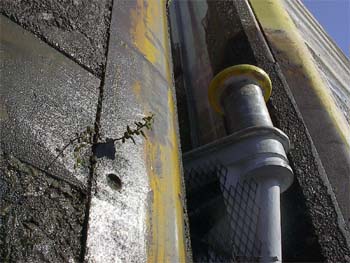 The Libelula had to go through a number of locks this week, and we have become quite proficient at getting her through. Unlike the locks on the upper Allegheny, most of the locks on the Ohio have large movable mooring bitts that slide down the side of the lock wall as the water level lowers. We tie one end of a line to the bow, or front, of the boat, pass it around the inside of the bit, and then tie it off to the stern, or back, of the boat. This keeps us from swinging around too violently as the water moves out of the lock. The wheels that slide the bitt down the wall are generally silent, but at one lock this week, someone had forgotten to grease them in a while, and they squeaked something awful. Between the moaning of the wheels themselves and the echoes the sounds produced as they bounced off the sides of the deep lock, it felt as if we were in a creepy movie. In this picture, a bit moves by a small piece of life in the lock--plants often grow in the cracks of the walls and on the doors of the lock, even though they frequently get covered with water when the lock is full. The Libelula had to go through a number of locks this week, and we have become quite proficient at getting her through. Unlike the locks on the upper Allegheny, most of the locks on the Ohio have large movable mooring bitts that slide down the side of the lock wall as the water level lowers. We tie one end of a line to the bow, or front, of the boat, pass it around the inside of the bit, and then tie it off to the stern, or back, of the boat. This keeps us from swinging around too violently as the water moves out of the lock. The wheels that slide the bitt down the wall are generally silent, but at one lock this week, someone had forgotten to grease them in a while, and they squeaked something awful. Between the moaning of the wheels themselves and the echoes the sounds produced as they bounced off the sides of the deep lock, it felt as if we were in a creepy movie. In this picture, a bit moves by a small piece of life in the lock--plants often grow in the cracks of the walls and on the doors of the lock, even though they frequently get covered with water when the lock is full.
|
 A most peculiar sight greeted us Wednesday morning as we rose to continue on to the school in St. Mary's, WV. As the early morning mist flowed in spirals across the water, an old time sailing ship appeared from out of the lingering fog, which can be seen in the photo at left. It is an odd sight to see a boat like this on the ocean, but the fact that it was along the Ohio River made it especially mysterious. Aimee hailed them over the VHF radio saying, "Funny looking pirate ship, pirate ship, pirate ship, this the BPV Libelula ." In retrospect, perhaps not the most professional way to get the crews' attention, but you must understand we were in a bit of shock. The voice on the other end of the radio explained that they were a replica of Christopher Columbus's vessel the Niña and were on their way up to Pittsburgh. A most peculiar sight greeted us Wednesday morning as we rose to continue on to the school in St. Mary's, WV. As the early morning mist flowed in spirals across the water, an old time sailing ship appeared from out of the lingering fog, which can be seen in the photo at left. It is an odd sight to see a boat like this on the ocean, but the fact that it was along the Ohio River made it especially mysterious. Aimee hailed them over the VHF radio saying, "Funny looking pirate ship, pirate ship, pirate ship, this the BPV Libelula ." In retrospect, perhaps not the most professional way to get the crews' attention, but you must understand we were in a bit of shock. The voice on the other end of the radio explained that they were a replica of Christopher Columbus's vessel the Niña and were on their way up to Pittsburgh.
|
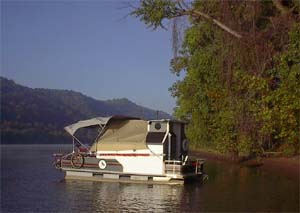 The previous evening we had chosen this spot to stay at for the night based on the fact that the shore looked sandy, which meant that it probably wouldn't have any rocks that could damage the bottom of the boat. It also meant that it would be easy to drive the spud into the ground. The spud is simply a strong metal pole about six feet tall that goes through a hole in the front of the boat and drives deep into the mud in order to keep the boat securely in place. We usually tie a line from the boat to a tree around shore as a back-up measure in case the spud slips in the middle of the night. The tan structure on the top of the boat about amidships is the top half of a tent we put up over our bunks at night. It allows us the freedom to stand up inside while still being protected from rain and the cold. It proved a problem last week in Pittsburgh, however. About 5am Thursday an incredibly strong storm blew in with winds gusting to 50mph. We awoke to the tent shaking violently, which caused one of the clamps that holds that tent down to snap off. We quickly decided to take the tent down and managed to do it without getting the inside of the boat wet by first covering it with a tarp. As soon as we had things under control the alarm clock sounded--it was time to wake up! If the weather is predicted to bring strong winds such as those, or if we are underway in rain, we now put this tarp up instead of the tent. It lies flat across the roof except for a small arch in the middle that keeps water from collecting and spilling into the boat. The previous evening we had chosen this spot to stay at for the night based on the fact that the shore looked sandy, which meant that it probably wouldn't have any rocks that could damage the bottom of the boat. It also meant that it would be easy to drive the spud into the ground. The spud is simply a strong metal pole about six feet tall that goes through a hole in the front of the boat and drives deep into the mud in order to keep the boat securely in place. We usually tie a line from the boat to a tree around shore as a back-up measure in case the spud slips in the middle of the night. The tan structure on the top of the boat about amidships is the top half of a tent we put up over our bunks at night. It allows us the freedom to stand up inside while still being protected from rain and the cold. It proved a problem last week in Pittsburgh, however. About 5am Thursday an incredibly strong storm blew in with winds gusting to 50mph. We awoke to the tent shaking violently, which caused one of the clamps that holds that tent down to snap off. We quickly decided to take the tent down and managed to do it without getting the inside of the boat wet by first covering it with a tarp. As soon as we had things under control the alarm clock sounded--it was time to wake up! If the weather is predicted to bring strong winds such as those, or if we are underway in rain, we now put this tarp up instead of the tent. It lies flat across the roof except for a small arch in the middle that keeps water from collecting and spilling into the boat.
|
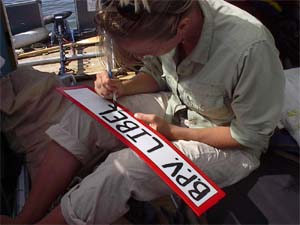
After completing our school presentation for the day, we headed off downriver and worked on completing some nameplates for the vessel. On the left, Aimee is painting one of two signs that we attached near the bow of the boat. You would never know that they are made from the old lid of a plastic container! |
 That evening we had to wait at the lock while a few other boats passed through. Both barges and commercial passenger boats get priority over private "recreational" boats such as ours. Almost all of the dams we've been to have two locks--one is quite large and the other is about half the length of the big one. In this picture Aimee sits on the roof watching a towboat push about fifteen barges loaded with coal into the larger chamber. The frame of the tent is in the lower right hand side of the picture. We usually leave the frame up during the day; take the tent down, and bungee cord the rain fly to the top of the frame. While waiting to lock through we had hung the River WaterWorks banner on the frame for all to see. That evening we had to wait at the lock while a few other boats passed through. Both barges and commercial passenger boats get priority over private "recreational" boats such as ours. Almost all of the dams we've been to have two locks--one is quite large and the other is about half the length of the big one. In this picture Aimee sits on the roof watching a towboat push about fifteen barges loaded with coal into the larger chamber. The frame of the tent is in the lower right hand side of the picture. We usually leave the frame up during the day; take the tent down, and bungee cord the rain fly to the top of the frame. While waiting to lock through we had hung the River WaterWorks banner on the frame for all to see.
|
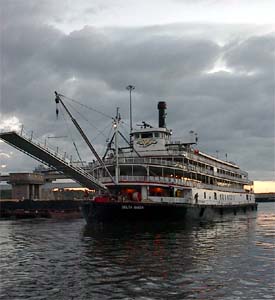 We are almost always directed to proceed through the smaller lock without delay, but today we had to wait; another boat was being brought upriver and had to come through before we could go down. As we wondered what kind of boat would be using the smaller lock, a most peculiar music broke the still evening air. It sounded like a breathy organ, and after a few moments we realized that the tune was a medley of old classics, in particular a few songs from older Disney movies. We also noticed puffs of white smoke rising over the closed lock doors. Morgan quickly realized that music must have been coming from a calliope--an old-fashioned steam organ. We speculated that the boat coming through the lock must have been a commercial passenger boat--a small river cruise ship. Sure enough, the lock doors swung open to reveal this old fashioned stern-wheeler named the Delta Queen. A quick radio to the captain let us know that she had started in Cincinnati and was on her way to Pittsburgh. As she passed by on her way out the lock, we waved to the deckhands and to the passengers who had just sat down inside for their evening meal. It was a great way to end a day that had started out with a visit from Columbus's Niña. We are almost always directed to proceed through the smaller lock without delay, but today we had to wait; another boat was being brought upriver and had to come through before we could go down. As we wondered what kind of boat would be using the smaller lock, a most peculiar music broke the still evening air. It sounded like a breathy organ, and after a few moments we realized that the tune was a medley of old classics, in particular a few songs from older Disney movies. We also noticed puffs of white smoke rising over the closed lock doors. Morgan quickly realized that music must have been coming from a calliope--an old-fashioned steam organ. We speculated that the boat coming through the lock must have been a commercial passenger boat--a small river cruise ship. Sure enough, the lock doors swung open to reveal this old fashioned stern-wheeler named the Delta Queen. A quick radio to the captain let us know that she had started in Cincinnati and was on her way to Pittsburgh. As she passed by on her way out the lock, we waved to the deckhands and to the passengers who had just sat down inside for their evening meal. It was a great way to end a day that had started out with a visit from Columbus's Niña.
|
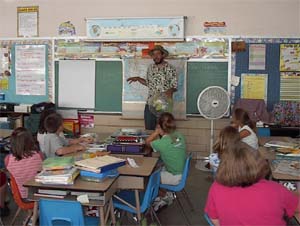 Early the next morning we made our way to one of the oldest cities on the Ohio River, Marietta, Ohio. A large river called the Muskingum joins the Ohio River in Marietta, and the elementary school we visited that morning was located at the point of land where the two rivers meet. We visited two fourth grade classrooms that morning and talked about all things related to water. Here, Morgan explains how he first got the idea to go on the journey as he uses the beach ball globe in his hand to talk about how all of the different oceans in the world are really the same body of water. We use the U.S. map behind him to show the students the path of our river journey as well as the location of other major rivers in the states. Early the next morning we made our way to one of the oldest cities on the Ohio River, Marietta, Ohio. A large river called the Muskingum joins the Ohio River in Marietta, and the elementary school we visited that morning was located at the point of land where the two rivers meet. We visited two fourth grade classrooms that morning and talked about all things related to water. Here, Morgan explains how he first got the idea to go on the journey as he uses the beach ball globe in his hand to talk about how all of the different oceans in the world are really the same body of water. We use the U.S. map behind him to show the students the path of our river journey as well as the location of other major rivers in the states.
|
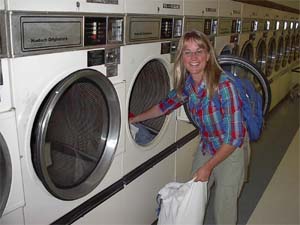 We took advantage of being in a larger town by doing a number of chores and errands in Marietta. Among other things we visited the Laundromat and the hardware store, picked up some groceries for the week, repaired a broken pulley on the bike, and worked on updating the website. We also were able to fill up our water and take showers at the marina that hosted us for the night. Getting all of these things done took a little while longer than expected and we did not leave until Friday afternoon. We headed out under paddle wheel power alone, done with our re-supply and ready and refreshed to bike to our next school nearly a hundred miles down river. We took advantage of being in a larger town by doing a number of chores and errands in Marietta. Among other things we visited the Laundromat and the hardware store, picked up some groceries for the week, repaired a broken pulley on the bike, and worked on updating the website. We also were able to fill up our water and take showers at the marina that hosted us for the night. Getting all of these things done took a little while longer than expected and we did not leave until Friday afternoon. We headed out under paddle wheel power alone, done with our re-supply and ready and refreshed to bike to our next school nearly a hundred miles down river.
|
| |
|
Read More About Next Week >>> |
|


 We awoke on Sunday morning to find ourselves still about 70 miles from the school we were scheduled to visit on Monday. So, we gritted our teeth and turned on the motor, not wishing to fall behind schedule yet again. As we rounded one of the first bends in the river, we spotted the source of the white smoke that we had noticed the night before. The locals just up river had told us to keep our eyes open for the sight, but there was no way we could have missed it--the tall, rotund cooling towers of a nuclear power plant. It was quite a feeling to be gliding past these huge power generators in our small craft. In addition to being a nuclear power plant, you can tell from the above picture that this plant also used coal to create electricity because of the tall, skinny chimneys to the left in the photo.
We awoke on Sunday morning to find ourselves still about 70 miles from the school we were scheduled to visit on Monday. So, we gritted our teeth and turned on the motor, not wishing to fall behind schedule yet again. As we rounded one of the first bends in the river, we spotted the source of the white smoke that we had noticed the night before. The locals just up river had told us to keep our eyes open for the sight, but there was no way we could have missed it--the tall, rotund cooling towers of a nuclear power plant. It was quite a feeling to be gliding past these huge power generators in our small craft. In addition to being a nuclear power plant, you can tell from the above picture that this plant also used coal to create electricity because of the tall, skinny chimneys to the left in the photo.  The picture to the left composes an interesting juxtaposition of bicycle power and nuclear power, perhaps making some sort of powerful statement? Whoa. This week was the first in our journey that really exposed us to the amount of industry along the river. In addition to a number of power plants, we also passed facilities involved in barge shipping and all sorts of goods being manufactured. The charts we have usually note what company is set up along the river, so if we know the company name, we can guess what is going on inside the factory. For example, we passed the Bayer plant, so we could presume that aspirin, or some ingredient of aspirin, was being manufactured inside, but when the chart just says "Koppers Industries, Inc." all we can do is guess!
The picture to the left composes an interesting juxtaposition of bicycle power and nuclear power, perhaps making some sort of powerful statement? Whoa. This week was the first in our journey that really exposed us to the amount of industry along the river. In addition to a number of power plants, we also passed facilities involved in barge shipping and all sorts of goods being manufactured. The charts we have usually note what company is set up along the river, so if we know the company name, we can guess what is going on inside the factory. For example, we passed the Bayer plant, so we could presume that aspirin, or some ingredient of aspirin, was being manufactured inside, but when the chart just says "Koppers Industries, Inc." all we can do is guess!  Still early in the day on Sunday we left Pennsylvania and the river became a state line, with Ohio on the right and West Virginia on the left. It won't be until about mid-December when we are once again within a state instead of being along its border. Nothing really changed along the river when we crossed over, but we did get a nice big welcome from Ohio, as shown in the picture on the right. As it turned out West Virginia was equally welcoming--we pulled up next to a dock after a long day on the water and almost immediately met a fellow who offered us his car in order to drive to town and get supplies. How could we refuse? We gratefully accepted his offer and he sent us off in his car, but not before he put a CD in his stereo so we would have some music to accompany our trip around town. Due to this good fortune, we were able to do some grocery shopping, stop at the hardware store, pick up some more gas, and grab a bite to eat--quite a luxury!
Still early in the day on Sunday we left Pennsylvania and the river became a state line, with Ohio on the right and West Virginia on the left. It won't be until about mid-December when we are once again within a state instead of being along its border. Nothing really changed along the river when we crossed over, but we did get a nice big welcome from Ohio, as shown in the picture on the right. As it turned out West Virginia was equally welcoming--we pulled up next to a dock after a long day on the water and almost immediately met a fellow who offered us his car in order to drive to town and get supplies. How could we refuse? We gratefully accepted his offer and he sent us off in his car, but not before he put a CD in his stereo so we would have some music to accompany our trip around town. Due to this good fortune, we were able to do some grocery shopping, stop at the hardware store, pick up some more gas, and grab a bite to eat--quite a luxury!  The next afternoon the people of West Virginia once again came through for us. We arrived at Moundsville, WV with little time to spare and quickly ran the boat into mud and set the spud. As we made our way up the embankment with all of the classroom gear, two construction workers on the roof of a house noticed the strange arrival. They questioned us and quickly offered to give us a lift to the school when they learned of our purpose. After the school presentation we did a quick walk around town and learned that the creek we had pulled into--Little Grave Creek--was related to the name of the town itself. Moundsville gets its name from a large mound that researchers believe was used as an Indian burial ground. We set off down the river once again. Another surprising thing we've seen along the river is the number of old barges left along the banks. At first glance, one might think they are simply abandoned--which they are--but they have been abandoned there for a reason. They have been left along the side of the river to keep the banks from eroding away--to help keep the river in its place. In this picture to the left, it looks like the locals have taken advantage of the old barges and extended their yards onto the tops, adding grass, flagpoles, and the like.
The next afternoon the people of West Virginia once again came through for us. We arrived at Moundsville, WV with little time to spare and quickly ran the boat into mud and set the spud. As we made our way up the embankment with all of the classroom gear, two construction workers on the roof of a house noticed the strange arrival. They questioned us and quickly offered to give us a lift to the school when they learned of our purpose. After the school presentation we did a quick walk around town and learned that the creek we had pulled into--Little Grave Creek--was related to the name of the town itself. Moundsville gets its name from a large mound that researchers believe was used as an Indian burial ground. We set off down the river once again. Another surprising thing we've seen along the river is the number of old barges left along the banks. At first glance, one might think they are simply abandoned--which they are--but they have been abandoned there for a reason. They have been left along the side of the river to keep the banks from eroding away--to help keep the river in its place. In this picture to the left, it looks like the locals have taken advantage of the old barges and extended their yards onto the tops, adding grass, flagpoles, and the like.  The Libelula had to go through a number of locks this week, and we have become quite proficient at getting her through. Unlike the locks on the upper Allegheny, most of the locks on the Ohio have large movable mooring bitts that slide down the side of the lock wall as the water level lowers. We tie one end of a line to the bow, or front, of the boat, pass it around the inside of the bit, and then tie it off to the stern, or back, of the boat. This keeps us from swinging around too violently as the water moves out of the lock. The wheels that slide the bitt down the wall are generally silent, but at one lock this week, someone had forgotten to grease them in a while, and they squeaked something awful. Between the moaning of the wheels themselves and the echoes the sounds produced as they bounced off the sides of the deep lock, it felt as if we were in a creepy movie. In this picture, a bit moves by a small piece of life in the lock--plants often grow in the cracks of the walls and on the doors of the lock, even though they frequently get covered with water when the lock is full.
The Libelula had to go through a number of locks this week, and we have become quite proficient at getting her through. Unlike the locks on the upper Allegheny, most of the locks on the Ohio have large movable mooring bitts that slide down the side of the lock wall as the water level lowers. We tie one end of a line to the bow, or front, of the boat, pass it around the inside of the bit, and then tie it off to the stern, or back, of the boat. This keeps us from swinging around too violently as the water moves out of the lock. The wheels that slide the bitt down the wall are generally silent, but at one lock this week, someone had forgotten to grease them in a while, and they squeaked something awful. Between the moaning of the wheels themselves and the echoes the sounds produced as they bounced off the sides of the deep lock, it felt as if we were in a creepy movie. In this picture, a bit moves by a small piece of life in the lock--plants often grow in the cracks of the walls and on the doors of the lock, even though they frequently get covered with water when the lock is full.  A most peculiar sight greeted us Wednesday morning as we rose to continue on to the school in St. Mary's, WV. As the early morning mist flowed in spirals across the water, an old time sailing ship appeared from out of the lingering fog, which can be seen in the photo at left. It is an odd sight to see a boat like this on the ocean, but the fact that it was along the Ohio River made it especially mysterious. Aimee hailed them over the VHF radio saying, "Funny looking pirate ship, pirate ship, pirate ship, this the BPV Libelula ." In retrospect, perhaps not the most professional way to get the crews' attention, but you must understand we were in a bit of shock. The voice on the other end of the radio explained that they were a replica of Christopher Columbus's vessel the Niña and were on their way up to Pittsburgh.
A most peculiar sight greeted us Wednesday morning as we rose to continue on to the school in St. Mary's, WV. As the early morning mist flowed in spirals across the water, an old time sailing ship appeared from out of the lingering fog, which can be seen in the photo at left. It is an odd sight to see a boat like this on the ocean, but the fact that it was along the Ohio River made it especially mysterious. Aimee hailed them over the VHF radio saying, "Funny looking pirate ship, pirate ship, pirate ship, this the BPV Libelula ." In retrospect, perhaps not the most professional way to get the crews' attention, but you must understand we were in a bit of shock. The voice on the other end of the radio explained that they were a replica of Christopher Columbus's vessel the Niña and were on their way up to Pittsburgh.  The previous evening we had chosen this spot to stay at for the night based on the fact that the shore looked sandy, which meant that it probably wouldn't have any rocks that could damage the bottom of the boat. It also meant that it would be easy to drive the spud into the ground. The spud is simply a strong metal pole about six feet tall that goes through a hole in the front of the boat and drives deep into the mud in order to keep the boat securely in place. We usually tie a line from the boat to a tree around shore as a back-up measure in case the spud slips in the middle of the night. The tan structure on the top of the boat about amidships is the top half of a tent we put up over our bunks at night. It allows us the freedom to stand up inside while still being protected from rain and the cold. It proved a problem last week in Pittsburgh, however. About 5am Thursday an incredibly strong storm blew in with winds gusting to 50mph. We awoke to the tent shaking violently, which caused one of the clamps that holds that tent down to snap off. We quickly decided to take the tent down and managed to do it without getting the inside of the boat wet by first covering it with a tarp. As soon as we had things under control the alarm clock sounded--it was time to wake up! If the weather is predicted to bring strong winds such as those, or if we are underway in rain, we now put this tarp up instead of the tent. It lies flat across the roof except for a small arch in the middle that keeps water from collecting and spilling into the boat.
The previous evening we had chosen this spot to stay at for the night based on the fact that the shore looked sandy, which meant that it probably wouldn't have any rocks that could damage the bottom of the boat. It also meant that it would be easy to drive the spud into the ground. The spud is simply a strong metal pole about six feet tall that goes through a hole in the front of the boat and drives deep into the mud in order to keep the boat securely in place. We usually tie a line from the boat to a tree around shore as a back-up measure in case the spud slips in the middle of the night. The tan structure on the top of the boat about amidships is the top half of a tent we put up over our bunks at night. It allows us the freedom to stand up inside while still being protected from rain and the cold. It proved a problem last week in Pittsburgh, however. About 5am Thursday an incredibly strong storm blew in with winds gusting to 50mph. We awoke to the tent shaking violently, which caused one of the clamps that holds that tent down to snap off. We quickly decided to take the tent down and managed to do it without getting the inside of the boat wet by first covering it with a tarp. As soon as we had things under control the alarm clock sounded--it was time to wake up! If the weather is predicted to bring strong winds such as those, or if we are underway in rain, we now put this tarp up instead of the tent. It lies flat across the roof except for a small arch in the middle that keeps water from collecting and spilling into the boat. 
 That evening we had to wait at the lock while a few other boats passed through. Both barges and commercial passenger boats get priority over private "recreational" boats such as ours. Almost all of the dams we've been to have two locks--one is quite large and the other is about half the length of the big one. In this picture Aimee sits on the roof watching a towboat push about fifteen barges loaded with coal into the larger chamber. The frame of the tent is in the lower right hand side of the picture. We usually leave the frame up during the day; take the tent down, and bungee cord the rain fly to the top of the frame. While waiting to lock through we had hung the River WaterWorks banner on the frame for all to see.
That evening we had to wait at the lock while a few other boats passed through. Both barges and commercial passenger boats get priority over private "recreational" boats such as ours. Almost all of the dams we've been to have two locks--one is quite large and the other is about half the length of the big one. In this picture Aimee sits on the roof watching a towboat push about fifteen barges loaded with coal into the larger chamber. The frame of the tent is in the lower right hand side of the picture. We usually leave the frame up during the day; take the tent down, and bungee cord the rain fly to the top of the frame. While waiting to lock through we had hung the River WaterWorks banner on the frame for all to see.  We are almost always directed to proceed through the smaller lock without delay, but today we had to wait; another boat was being brought upriver and had to come through before we could go down. As we wondered what kind of boat would be using the smaller lock, a most peculiar music broke the still evening air. It sounded like a breathy organ, and after a few moments we realized that the tune was a medley of old classics, in particular a few songs from older Disney movies. We also noticed puffs of white smoke rising over the closed lock doors. Morgan quickly realized that music must have been coming from a calliope--an old-fashioned steam organ. We speculated that the boat coming through the lock must have been a commercial passenger boat--a small river cruise ship. Sure enough, the lock doors swung open to reveal this old fashioned stern-wheeler named the Delta Queen. A quick radio to the captain let us know that she had started in Cincinnati and was on her way to Pittsburgh. As she passed by on her way out the lock, we waved to the deckhands and to the passengers who had just sat down inside for their evening meal. It was a great way to end a day that had started out with a visit from Columbus's Niña.
We are almost always directed to proceed through the smaller lock without delay, but today we had to wait; another boat was being brought upriver and had to come through before we could go down. As we wondered what kind of boat would be using the smaller lock, a most peculiar music broke the still evening air. It sounded like a breathy organ, and after a few moments we realized that the tune was a medley of old classics, in particular a few songs from older Disney movies. We also noticed puffs of white smoke rising over the closed lock doors. Morgan quickly realized that music must have been coming from a calliope--an old-fashioned steam organ. We speculated that the boat coming through the lock must have been a commercial passenger boat--a small river cruise ship. Sure enough, the lock doors swung open to reveal this old fashioned stern-wheeler named the Delta Queen. A quick radio to the captain let us know that she had started in Cincinnati and was on her way to Pittsburgh. As she passed by on her way out the lock, we waved to the deckhands and to the passengers who had just sat down inside for their evening meal. It was a great way to end a day that had started out with a visit from Columbus's Niña.  Early the next morning we made our way to one of the oldest cities on the Ohio River, Marietta, Ohio. A large river called the Muskingum joins the Ohio River in Marietta, and the elementary school we visited that morning was located at the point of land where the two rivers meet. We visited two fourth grade classrooms that morning and talked about all things related to water. Here, Morgan explains how he first got the idea to go on the journey as he uses the beach ball globe in his hand to talk about how all of the different oceans in the world are really the same body of water. We use the U.S. map behind him to show the students the path of our river journey as well as the location of other major rivers in the states.
Early the next morning we made our way to one of the oldest cities on the Ohio River, Marietta, Ohio. A large river called the Muskingum joins the Ohio River in Marietta, and the elementary school we visited that morning was located at the point of land where the two rivers meet. We visited two fourth grade classrooms that morning and talked about all things related to water. Here, Morgan explains how he first got the idea to go on the journey as he uses the beach ball globe in his hand to talk about how all of the different oceans in the world are really the same body of water. We use the U.S. map behind him to show the students the path of our river journey as well as the location of other major rivers in the states.  We took advantage of being in a larger town by doing a number of chores and errands in Marietta. Among other things we visited the Laundromat and the hardware store, picked up some groceries for the week, repaired a broken pulley on the bike, and worked on updating the website. We also were able to fill up our water and take showers at the marina that hosted us for the night. Getting all of these things done took a little while longer than expected and we did not leave until Friday afternoon. We headed out under paddle wheel power alone, done with our re-supply and ready and refreshed to bike to our next school nearly a hundred miles down river.
We took advantage of being in a larger town by doing a number of chores and errands in Marietta. Among other things we visited the Laundromat and the hardware store, picked up some groceries for the week, repaired a broken pulley on the bike, and worked on updating the website. We also were able to fill up our water and take showers at the marina that hosted us for the night. Getting all of these things done took a little while longer than expected and we did not leave until Friday afternoon. We headed out under paddle wheel power alone, done with our re-supply and ready and refreshed to bike to our next school nearly a hundred miles down river.